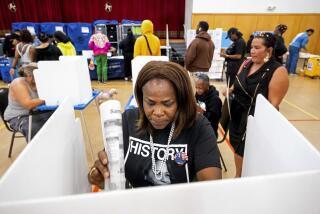The Potential for Political Nightmare : Three-way presidential race could hand decision to House
- Share via
Suppose they held a presidential election and nobody won? That’s always a theoretical possibility whenever three or more serious candidates compete for the White House, as happened in the elections of 1824, 1860, 1912 and 1968. This year it could become more than theoretical. All that has to happen is for likely presidential candidate Ross Perot to carry enough states in November to deny either the Democratic or Republican candidate the 270 Electoral College votes needed for victory.
In that event Congress would have to decide the outcome of the election, with the House choosing the next President and the Senate the vice president. Therein lies a potential political nightmare.
CLOUTLESS CALIFORNIA: The Constitution says each state delegation in the House must vote as a unit, a procedure that gives a state like Alaska, with only a single representative, the same political weight as California, which has 52. To win the presidency, a candidate would need the votes of 26 states. Conceivably, if improbably, that majority could include none of the 12 largest states, whose combined populations exceed 150 million. The political clout of the heavily urbanized states, representing 60% of the people, could effectively be neutralized.
The representatives, when they assemble next January, would be those elected in November’s general election. Chances are that the new House would continue to have a Democratic majority, though some increase in Republican seats is expected. But what counts is not the number of seats one or the other party holds but the number of state delegations where one or the other party has a majority. The vote in the House for the next President would thus presumably be determined on the basis of which party controls at least 26 state delegations.
But what if the candidate of the party which had a majority of House delegations had finished second or even third in November’s presidential race? Would party loyalty prevail, leading to the choice of an also-ran or even of an also-also-ran? Or would representatives feel bound to support not necessarily the candidate of their particular party, but the one who had earlier drawn more popular votes than any other?
Nothing is certain, and this is where nightmarish possibilities arise. The sole precedent is not encouraging. In 1824, when a mere 356,000 votes were cast, none of the candidates won an electoral majority. The decision went to the House. There the Speaker, Henry Clay, the fourth man in the four-candidate race, threw his support to John Quincy Adams over Andrew Jackson. Chosen President, Adams named Clay as his secretary of state. Jackson’s supporters branded the deal a “corrupt bargain,” and for the next four years gave Adams no rest from denunciation.
DUBIOUS DEALS: The House, should it be required to name a President next January, would meet behind closed doors. Some are already worrying that this process could lead to not one but perhaps a host of dubious deals, further compromising the political legitimacy of whoever is named President. Meanwhile, the Senate would be meeting to name a vice president, with each senator voting individually. The Senate’s choice need not be of the same party as the House’s choice for President. The result could give rise to the mother of all modern political messes.
These anxiety-inducing scenarios have revived talk--it’s heard every 20 years or so--of a constitutional amendment for the direct popular election of the President and vice president. Whatever that idea’s merits, it’s far too late for Congress and the states to act in time for this year’s election. It’s always possible, of course, that the Perot candidacy will flame out, leaving electoral politics unaffected. It’s also possible, if barely, that the nation is headed toward a true constitutional crisis.
More to Read
Get the L.A. Times Politics newsletter
Deeply reported insights into legislation, politics and policy from Sacramento, Washington and beyond. In your inbox twice per week.
You may occasionally receive promotional content from the Los Angeles Times.










